

How to Soften Red Heart Super Saver Yarn. *Please note!

* if you are crocheting/knitting for hospitals or preemie babies this may not be a good method. They prefer no product has been used on yarn of donated hospital items. This week I crocheted a Nyan Cat themed lovey for my impending baby. Unfortunately, trying to make something rainbow takes a lot of colors, and buying all 7 ROYGBIV plus the grey, pink and tan is a lot of yarn money. I bought Red Heart Super Saver thinking it couldn't be THAT bad. I worked up the blanket part and it is bad - it would be scratchy and coarse for a baby at least. After a day or so of research and experimentation the blanket actually came out super soft :) It also had wonderful drape which I did not expect.
Guide to Amigurumi Doll Proportions. When working with proportions everything is measured by heads.
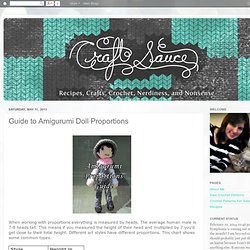
The average human male is 7-8 heads tall. This means if you measured the height of their head and multiplied by 7 you’d get close to their total height. Different art styles have different proportions. This chart shows some common types. Obviously these do vary from artist to artist. 5 Tips For Seaming Or Sewing Up Knit & Crochet Pieces. May 9th, 2011 by Zontee There comes a time in most knitters’ and crocheters’ lives when you want to tackle a project that has seams to be sewn up, whether it’s a top, a hat, an afghan, or a cardigan.
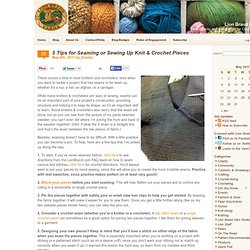
While many knitters & crocheters are wary of sewing, seams can be an important part of your project’s construction, providing structure and helping it to keep its shape, so it’s an important skill to learn. Some knitters & crocheters also worry that the seam will show, but as you can see from the picture of my partly seamed sweater, you can’t even tell where I’m joining the front and back of the sweater together! (Hint: Follow the V down in a straight line and that’s the seam between the two pieces of fabric.) Besides, seaming doesn’t have to be difficult. 1. Color Theory 101: Selecting Yarns That Go Together. A lot of patterns going around at the moment feature stripes: two or three colors that go together perfectly.
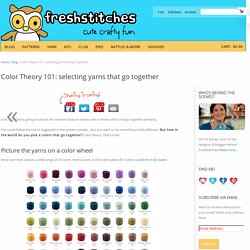
You could follow the colors suggested in the pattern sample… but you want to try something a little different. But how in the world do you pick a colors that go together? Color theory. That’s how! Most yarn lines contain a wide range of of colors. Whoa! But don’t fret. It’s not all of the yarns, of course! Most yarn companies design their colors of yarn with compatibility in mind. Fortunately, there’s a name for the art of picking colors that go together: color theory.
There are three color schemes that, if followed, will create knock-your-socks-off color combos: analogous, complementary and split complementary. Analogous Analogous colors are the ones that are next to each other on the color wheel: Granny Square Pattern/Join-as-you-go Method. Ive finished my granny baby blanket… Sorry it took a little longer than I thought it would to come back to you with it.
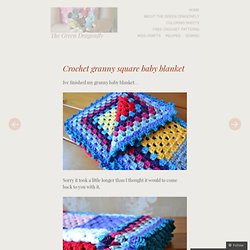
By the time I made the trip to spotlight to get the yarn to finish the edging…… and washed and blocked it (and waited… and waited) for it to dry… Fortunately there has just been a break in the weather so I rushed outside to find somewhere to photograph it, and try to get the colors as true as possible… Joining Granny Squares. When I join my Granny Squares together I always choose to crochet them rather than stitch them.
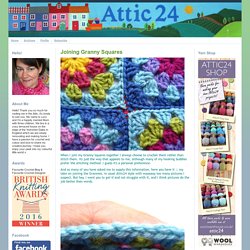
Its just the way that appeals to me, although many of my hooking buddies prefer the stitching method. I guess it's a personal preference. And as many of you have asked me to supply this information, here you have it :: my take on joining the Grannies, in usual Attic24 style with waaaaay too many pictures I suspect. How to make a crochet portrait pattern. Reading "cross stitch" crochet pattern. I crochet with cross stitch patterns. I have been crocheting with them for the past 2 years and I learned a lot. Taking apart a project (reusing yarn)
Cthylla Crochet - Tiffay Estela I reuse yarn a lot.

I'll have a finished project sometimes not just sitting in my closet. Just taking up space. (Chart Portrait) - Crocheting Border Using Two Colors. Crochet Border One Color. Cthylla Crochet - Tiffay Estela Throughout this tutorial I'll be using this chart as my "pattern.

" This chart has 22 box's across, so that equals 22 chains. Example One - Adding two extra chains 1) Chain 22 and add two more chains with border color. A total of 24 chains. 2) Single Crochet across = 24S C and chain one ( This is your first row 3-5) Single Crochet three more rows = Four rows of 24SC. (Don't forget to ch one at the end of the row.) 6) Chain one and SC in the first SC. 7) Keep repeating # 6 until you have finished your chart. Example Two- Adding four extra chains 1) Chain 22 and add four more chains.